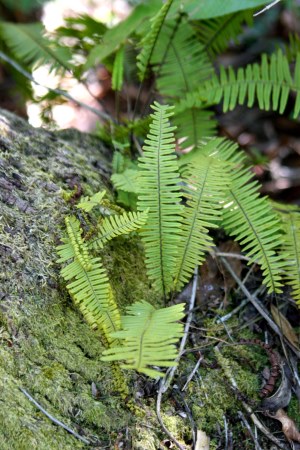Plants of South Florida · Plants by Conservation Area · Plants by County · Plants by Habitat Quick Search · Advanced Search |
||
|
|
||
 |
Pecluma plumula (Humb.%20 Plume%20polypody |
|
|
South Florida Status: Critically imperiled. Two occurrences in Everglades National Park. Taxonomy: Pteridophyte; Polypodiaceae. Habit: Perennial epiphytic herb. Distribution: Native to peninsular Florida, the West Indies, Mexico, Central America, and South America. Wunderlin (1998) reports it as frequent in peninsular Florida. South Florida Distribution: Miami-Dade County and the Monroe County Keys. South Florida Habitats: Rockland hammocks and mesic hammocks. Protection Status: Listed as endangered by FDACS and as imperiled by FNAI. Aids to Identification: Chafin (2000) has a color photo; Nelson (2000) has color photos; the IRC Website has a color photo. References: Chapman, 1883; Small, 1931b; Small, 1938; Evans, 1968; Lakela & Long, 1976; Long & Lakela, 1976; Correll & Correll 1982; Flora of North America Editorial Committee, 1993; Wunderlin, 1998; Chafin, 2000; Coile, 2000; Liogier & Martorell, 2000; Nelson, 2000; Wunderlin & Hansen, 2000. Synonyms: Polypodium plumula Humb. & Bonpl. ex Willd. Historical Context: C.L. Pollard first collected plume polypody in 1898 on Key Largo (203, US), but it has not been collected or observed there since that time. Pollard (1899) wrote that only a single plant was found on a dead tree trunk near the village of Aiken. John Kunkel Small made the next collection in 1919 in Miami-Dade County in a hammock about 20 miles southwest of Royal Palm Hammock (9179, NY), in what is now Everglades National Park. Nellie C. Knappen (1929) also collected it there in 1928 (s.n., US). Volunteer botanist Rick Seavey has observed what appears to be the same station in a hammock southeast of Mahogany Hammock (personal communication, 24 January 2001). He estimates that fewer than 100 plants are present. Plume polypody also has been collected on Long Pine Key in Everglades National Park, beginning with a Walter M. Buswell collection in 1938 (s.n., FTG). Frank C. Craighead also collected it there in 1961 (s.n., FTG). Carol Lippincott discovered a population in a hammock on Long Pine Key, which she later showed to Rick Seavey (R. Seavey, personal communication, 24 January 2001). Seavey estimates that there are about 10 plants in that hammock. Major Threats: Poaching; exotic pest plant invasions. Comments: More water delivery into the Long Pine Key area south of the main park road would probably help this species, as it requires relatively moist conditions and high humidity. However, an increase in water delivery into the area north of Long Pine Key and south of Mahogany Hammock could flood out the supporting trees and cause the extirpation of plume polypody. Recommendations: • Map and monitor known stations on a regular basis. • Protect from poaching. • Conduct research to determine the effects of the Everglades restoration on plume polypody. Update: Frank Craighead made an additional collection in Everglades National Park "2 miles west from Whiskey Creek", presumably in the area between Hells Bay and Paurotis Pond (Craighead s.n., FNPS). Mike Owen made a collection in 2001 at Koreshan State Historic Site (Owen KS0100, USF). A specimen at FAU (now FTG) from Martin County needs to be checked. During surveys from 2003-2008 no plants were found south of Main Park Road in Everglades National Park but the two populations north and west of Main Park Road were confirmed (Gann et al. 2009). Citation: Gann, G.D. 2014. Species Account Update, Pecluma plumula. Floristic Inventory of South Florida Database Online. The Institute for Regional Conservation. Delray Beach, Florida. |
||



